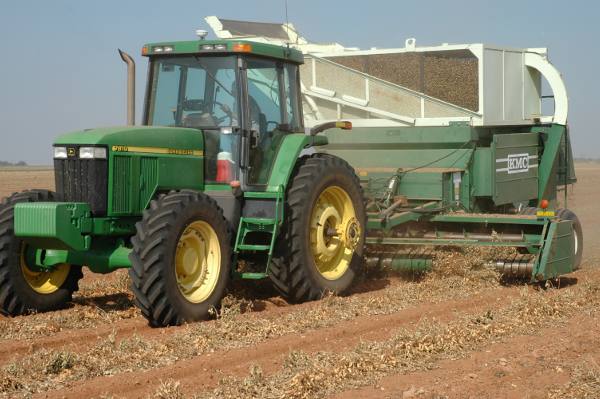
Texas peanut producers could harvest one of the worst crops on record this fall as the combination of reduced acreage, prolonged drought, record-breaking heat and high winds will result in a short, late crop that yields far below average.
“It’s not good,” says Todd Baughman, who until recently was the Texas AgriLife state peanut specialist and agronomist at Vernon. He started a new position as program support leader for the Oklahoma State University Institute of Biosciences last week. He’ll work out of Ardmore.
“We lost 60,000 acres of peanuts not planted last spring,” Baughman said, “so we started out in a hole.”
And it only got worse from there. “This could be one of the worst crops on record,” he said. “Drought, heat and lack of humidity kept plants from setting a crop until well into August. We set no pods in July.”
He says peanuts need adequate humidity to set flowers. “The combination of high heat and high winds meant not enough humidity. We tried to modify irrigation systems to help some but there is no cure-all.”
Baughman said this fall peanut producers are experiencing “everything we don’t want—a short crop, late. And we will have to have an open October, all month, or yield and grade will be even worse.”
Even with a good fall, Baughman expects yields to be significantly lower than usual. “A few fields with partial pivots or short pivots and good water may make more than 4,000 pounds per acre. I’ll be shocked to see 5,000 pounds. In areas that usually yield 6,000 pounds, farmers are hoping to make 4,000.”
He expects Texas average yield will be around 2,000 pounds per acre. “That’s 1,500 off the state average. Some expect to see 2,500, but I’m not that optimistic.”
Current conditions indicate the Texas crop is 18 percent very poor, 30 percent poor, 38 percent fair and only 14 percent good. No percentage of the Texas peanut crop is rated excellent.
Baughman said disease and insect pressure were almost non-existent this year. “Farmers didn’t have to spray for disease, and, in spite of the heat, insects were not a problem. We also didn’t have as long to worry about pod rot because we didn’t have pods until late.”
But peanut farmers spent a lot of money on irrigation. “Many say they equaled their normal years’ total electric bill by the first of July,” Baughman said. The same was true for cotton producers.
He doesn’t expect peanut acreage to rebound in 2012. “Moisture will be the key,” he said. “If we have the same scenario as we did last spring, it will hurt acreage. Even with better prices, farmers will not plant without adequate moisture.”
He said some might concentrate peanuts on their best land or best water. “We’ll probably see more peanuts under half-circles. But we could still see more loss than the 60,000 acres. I’m not certain that even with better moisture and better prices we’ll get back to 2011 acreage,” he said. “I don’t anticipate any acreage growth unless we see a major improvement in weather and price.”
Weather forecast doesn’t bode well for peanuts, and the continuing drought has caused concern among winter wheat producers as well.
“The summer was bad enough,” Baughman said. “Now, we can’t get wheat in the ground. “September and October planting time is a key for the Texas Rolling Plains. This is usually the time for moisture.”
But not this fall, at least not so far.
About the Author(s)
You May Also Like






